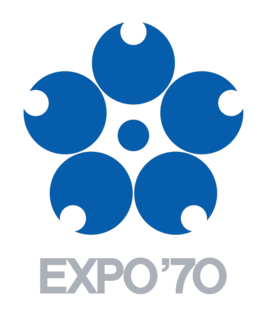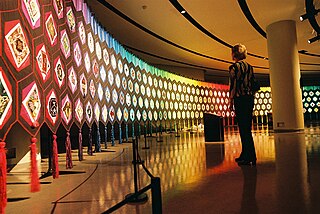
The Kaleidoscope Pavilion was a sponsored pavilion at Expo 67, the International World's Fair held in Montreal, Quebec, Canada in 1967.

The Kaleidoscope Pavilion was a sponsored pavilion at Expo 67, the International World's Fair held in Montreal, Quebec, Canada in 1967.
Designed to reflect a color-based theme, the pavilion acted as an oversized, three-dimensional color wheel. [1] Built in the shape of a carousel, it featured 112 colored fins that created the illusion the structure was moving as spectators moved across the Expo grounds. [2] The interior of the pavilion consisted of a 12-minute film titled Man and Color that was projected on oversized screens. [3] Shown over the course of three differently designed rooms, mirrors were used to create an abstract, reflection-driven experience of color. [1] Music for the exhibit was composed by R. Murray Schafer. [4] [1]
Sponsored by six Canadian chemical companies, the pavilion was designed by members of the University of Waterloo’s Institute of Design and Morley Markson and Associates, a Toronto-based industrial design firm. [3] The project director was University of Waterloo professor Vir Handa. [5]

The 1967 International and Universal Exposition or Expo 67, as it was commonly known, was a general exhibition, Category One World's Fair held in Montreal, Quebec, Canada, from April 27 to October 29, 1967. It is considered to be the most successful World's Fair of the 20th century with the most attendees to that date and 62 nations participating. It also set the single-day attendance record for a world's fair, with 569,500 visitors on its third day.

HABITAT 67, or simply Habitat, is a model community and housing complex in Montreal, Quebec, Canada, designed by Israeli-Canadian architect Moshe Safdie. It was originally conceived as his master's thesis at the School of Architecture at McGill University and then built as a pavilion for Expo 67, the World's Fair held from April to October 1967. It is at 2600 Avenue Pierre-Dupuy on the Marc-Drouin Quay next to the Saint Lawrence River. Habitat 67 is widely considered an architectural landmark and one of the most recognizable buildings in both Montreal and Canada.

Expo '70 was a world's fair held in Suita, Osaka Prefecture, Japan between March 15 and September 13, 1970. Its theme was "Progress and Harmony for Mankind." In Japanese, Expo '70 is often referred to as Osaka Banpaku. It was the first world's fair held in Japan.

Circle-Vision 360° is a film technique, refined by The Walt Disney Company, that uses nine cameras for nine big screens arranged in a circle. The cameras are usually mounted on top of an automobile for scenes through cities and highways, while films such as The Timekeeper use a static camera and many CGI effects. The first film was America the Beautiful in the Circarama theater, which had 11 projectors using 16mm film. And would become Circle-Vision in 1967, which has 9 projectors using 35mm film. Both the original 11-lens camera and the subsequent 9-lens camera, as well as their projection systems, were designed by longtime Disney animator and visual effects pioneer, Ub Iwerks.
"A Place to Stand, a Place to Grow" (Ontari-ari-ari-o!) is the unofficial provincial anthem of the Canadian province of Ontario. It was written as the signature tune for a movie of the same name that was featured at the Expo 67 Ontario pavilion.

Roderick "Rod" George Robbie, was a British-born Canadian architect and planner. He was known for his design of the Canadian Pavilion at Expo 67 and Toronto's Rogers Centre (SkyDome).
In the Labyrinth(French: Dans le labyrinthe) was a groundbreaking multi-screen presentation at the Labyrinth pavilion at Expo 67 in Montreal, Quebec, Canada. It used 35 mm and 70 mm film projected simultaneously on multiple screens and was the precursor of today's IMAX format.

The Quilt of Belonging is a collaborative textile arts project initiated by Canadian artist Esther Bryan.
Expo 67 was held in Montreal, Quebec, Canada. The opening week began at the end of April 1967. The official opening ceremonies for the 1967 International and Universal Exposition or Expo 67 occurred on Thursday, April 27 at the Place des Nations pavilion. On Friday, April 28, Expo 67's doors opened to the public and Al Carter was the first of over 330,000 visitors that day.

The Expo 67 International and Universal Exposition featured 90 pavilions representing Man and His World, on a theme derived from Terre des Hommes, written by the famous French pilot Antoine de Saint-Exupéry.
Gazell Macy DuBois M. Arch, P. Eng, PP-FRAIC, PP-RCA, FAIA (hon) was an American-born Canadian architect who designed several landmark Toronto buildings.
Gord Smith, is a Canadian artist who sculpts geometric forms in metal and wood. Smith originally learned to weld with a torch his older brother used to rebuild old cars. He is considered one of Canada's leading sculptors of the post-war period, and his work is marked by a great diversity of styles inspired by music, nature and other themes. Trained in architecture and engineering, he has produced work in metal that reflects a mastery of technique and conveys great flexibility.

Expo 2017 Astana was an International Exposition which took place from June 10 to September 10, 2017 in Nur-Sultan, Kazakhstan, which was called Astana at the time. The expo's theme was "Future Energy", and aimed to create a global debate between countries, nongovernmental organizations, companies and the general public on the crucial question: "How do we ensure safe and sustainable access to energy for all while reducing CO2 emissions?"
Expo This Week was a Canadian news television series which aired on CBC Television in 1967.

The Québec Pavilion at Expo 67 in Montreal was a steel and glass frustum structure built above a body of water between the Ontario and French Pavilions on Notre Dame Island.
Canada '67 is a Circle-Vision 360° documentary film by Canadian film director Robert Barclay, which was presented at the Telephone Pavilion,, part of Expo 67, an International World's Fair held in Montreal, Quebec, Canada in 1967 to mark the centenary of the Confederation of Canada.
A Place to Stand is a 1967 film produced and edited by the Canadian artist and filmmaker Christopher Chapman for the Ontario pavilion at Expo 67 in Montréal, Québec, Canada. For the film, he pioneered the concept of moving panes, of moving images, within the single context of the screen. At times there are 15 separate images moving at once. This technique, which he dubbed "multi-dynamic image technique" has since been employed in many films, notably Norman Jewison's 1968 film The Thomas Crown Affair. Mr. Jewison has credited Mr. Chapman as the creator of the edit style. The technique can also be seen more recently on television in the series 24.
Arcop was an architectural firm based in Montreal, renowned for designing many major projects in Canada including Place Bonaventure, Place Ville-Marie and Maison Alcan. The firm was originally formed as a partnership under the name Affleck, Desbarats, Lebensold, Michaud & Sise between Ray Affleck, Guy Desbarats, Jean Michaud, Fred Lebensold and Hazen Sise, all graduates and/or professors at the McGill School of Architecture. In 1959, after the departure of Michaud and the addition of Dimitri Dimakopoulos, another McGill Architecture graduate, the firm was renamed Affleck, Desbarats, Dimakopoulos, Lebensold, Sise which it maintained for a decade afterward. The company did not adopt the name Arcop, which stands for "Architects in Co-Partnership", until 1970.
We Are Young is a 1967 Canadian multi-screen documentary short film which was first presented in Montreal at Expo 67.

The Moscow Pavilion was designed as an exhibition pavilion for the Soviet Union at the international exhibition Expo 67 in Montreal, Quebec, Canada. The project was designed by a team of architects led by Mikhail Posokhin. Since the 1990s, the pavilion has been commonly called the Moscow Pavilion.